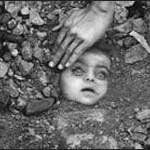Bhopal gas tragedy was a biggest industrial disaster that took place at a Union Carbide pesticide plant in the Indian city of Bhopal, Madhya Pradesh. At midnight on 3 December 1984, the plant accidentally released methyl isocyanides (MIC) gas, exposing more than 500,000 people to MIC and other chemicals. Twenty-five years have passed since that night of terror and death in Bhopal, which saw a cloud of deadly gases explode out of a faulty tank in a pesticide factory and silently spread into the homes of sleeping people

The official immediate death toll was 2,259. The government of Madhya Pradesh has confirmed a total of 3,787 deaths related to the gas release. During the night of December 2–3, 1984, large amounts of water entered tank 610, containing 42 tons of methyl isocyanate.
Although no official count of casualties has ever been done, estimates based on hospital and rehabilitation records show that about 20,000 people died and about 5.7 lakh suffered bodily damage, making it by far the world’s worst industrial disaster ever.
Many who breathed the highly toxic cocktail that night suffered a horrible death with multiple organ failure. Those who survived have suffered multiple diseases for 25 years. A report of the Gas Tragedy Relief Department of the state says that the morbidity rate (occurrence of ailments) is nearly 20% among gas-affected persons compared to about 5% among the unaffected population.
In February 1989, the Supreme Court announced that it was approving a settlement for Bhopal victims under which Union Carbide agreed to pay Rs 713 crore for compensation to victims, while the government agreed to drop all criminal cases against it. However, due to intense public shock and anger at letting off the culprits, the court agreed to reopen the criminal cases in 1991. Two installments of compensation — of up to Rs 25,000 each — have been given till now to the injured, one in 1994 and the next in 2004.
Another dimension of the ongoing tragedy of Bhopal is the poisonous chemical waste lying around in the abandoned premises of the pesticide plant. Several committees have inspected it and found 44,000 kgs of tarry residues and 25,000 kgs of alpha naphthol lying in the open since 1984. Various studies have established that the soil, ground water, vegetables and even breast milk have traces of toxic chemicals.






